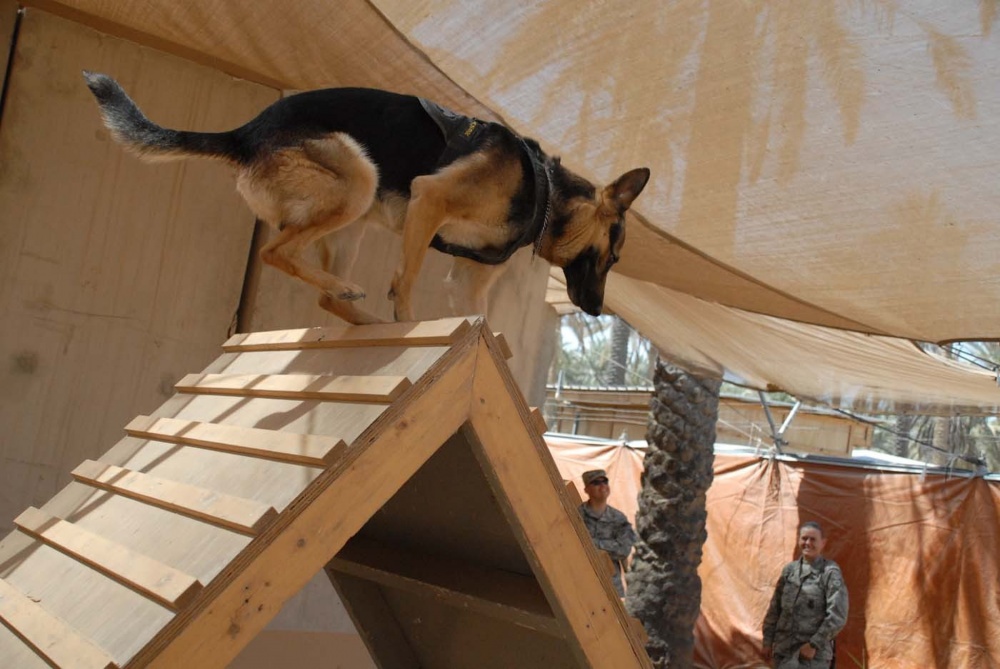

It’s no secret that servicemembers hold a special place in their hearts for our furry four-legged counterparts. There’s something about just seeing a dog in a warzone that (when you’re on the same side) can brighten your day, even if just for a few moments.
The history of the military working dog goes back many thousands of years, when mastiff-type dogs and other large breeds were armored and trained to break enemy lines or be released during retreats to run-down survivors. Most major powers have some documented instances of using dogs in a war capacity, from the Achaemenid empire in their campaigns against the Egyptians to the Spanish conquistadors during their conquest of the new world.
Though we’ve gotten away from using dogs in direct combat roles (for the most part), military working dogs have had a place on American battlefields since the early 19th century when they were used to send messages and guard prisoners of war during the Seminole and Civil Wars.
During World War I, when artillery would routinely cut communications wire and snipers eagerly targeted repair crews, dogs were commonly used to relay messages between command nodes. Unfortunately, their casualty rates were often higher than that of their human masters. It’s estimated that over a million were killed in combat or due to combat-related events.
On today’s battlefields military working dogs are more commonly seen in bomb and narco-sniffing roles, though attack dogs are still used in specialized teams. While their loyalty to their handlers and allies is unwavering to the point of death, these are not animals you want to face as an enemy
While most people can rattle off the names of some of the more famous American heroes of the last few centuries, far fewer are likely to know about the military working dogs that performed deeds just as incredible.
Sergeant Stubby
Stubby was a Boston Terrier mutt who was smuggled to the front lines by an American corporal who found him during training in 1916. In France he served with the 102nd Infantry Regiment. Wounded twice, the dog’s exploits were the stuff of legend. Having been fitted with a special gas mask, he would warn his unit of mustard gas attacks, and since he could hear incoming artillery before his human companions, would alert them with enough time to take cover. During one campaign he was responsible for the capture of a German spy. Because of this act the commander of his unit promoted Stubby to sergeant. During his career Stubby participated in 17 separate battles with the men of the 102nd.
After returning home to a hero’s welcome, Stubby died in his sleep at the age of 10. After his death he was subsequently preserved and given to the Smithsonian by his lifelong owner.
Chips
Chips was a German Shepherd-Collie who was donated to the War Dog Training Center for service during World War Two.
Assigned to the 3rd Infantry Division, Chips followed that unit from Africa to Germany, serving as a sentry and attack dog.
During Operation Husky, the invasion of Sicily, Chips and his men were pinned down by an enemy gun team. He charged their fortification and attacked the four soldiers inside, who promptly surrendered to the Americans. Wounded during the fight, he still went on to assist in the capture of 10 more Italian soldiers, earning the Silver Star, Purple Heart, and Distinguished Service Cross. He survived the war and returned to his family after the conflict ended, passing away in 1946.
Lucca
A German Shepherd-Malinois, Lucca was a military working dog assigned to a US Marine Corps dog handling team. During her career she deployed to both Iraq and Afghanistan, conducting over 400 combat patrols and detecting thousands of pounds of explosives and munitions. Saving the lives of countless thousands of servicemembers, her career ended in 2012 during a patrol in Afghanistan. She discovered a large improvised explosive device and had moved on to clear the rest of the area when she triggered a secondary explosive. While she lost a leg to the explosion, her handler was able to perform treatment and stabilize her until a MEDEVAC arrived. Lucca went on to live with another marine until her death in 2018 at the ripe old age of 14.
The incredible and true stories of these furry heroes are larger than life, and just a small sampling of the thousands of American dogs who have served during times of war. Countless others gave their lives for their human comrades, and it’s this sacrifice that’s honored with the series Hero Dogs on Fox Nation.
For a limited time military members and veterans can get a one year subscription to Fox Nation programs absolutely free, so you can enjoy learning more about these incredible animals and many others who have fought alongside our servicemen and women. Click here to learn how.
This article is sponsored by Fox Nation.
